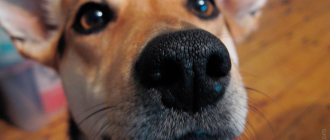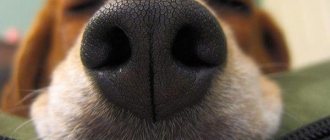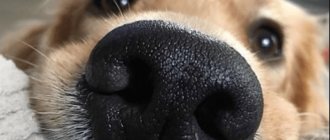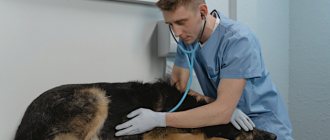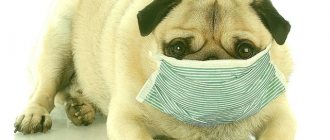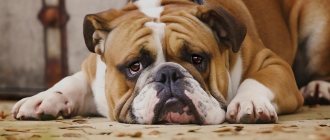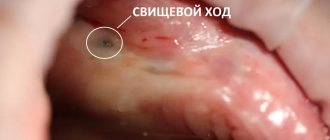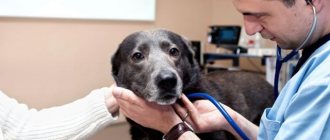A pet not only brings joy to its owner, but also imposes great responsibility on him. Every pet owner must provide their pet with a place to live and adequate food. You should also carefully monitor the animal’s health and, if necessary, take measures to treat it.
Many dog diseases can be diagnosed based on characteristic signs. One of them is nasal dryness. If your dog has a dry nose, the animal may be sick and should be closely monitored.
Causes of dryness
A dry and hot nose can have many different causes, not all of them necessarily caused by serious illnesses. However, the appearance of cracks, especially their inflammation, is already a threat to the well-being of the animal, a signal that adequate measures must be urgently taken.
In a dog, a change in the condition of the nose can be caused by the following factors:
- Age and heredity. In most puppies, a warm nose is a common occurrence, and for some breeds with slow metabolisms it is normal.
- During or immediately after sleep, most domestic dogs have a warm and dry nose. This is not a violation, rather a normal condition. This state of affairs, combined with the animal’s lethargy, lack of appetite, increased general body temperature and other signs of disease, should cause alarm.
- Fatigue. A dog that has run around and played too much does not regulate the functions of its body well; its nose may become dry.
These are natural reasons why your nose may feel dry and warm. The appearance of cracks almost always indicates the presence of a serious pathology:
- Consequence of injury. When struck, the sensitive membranes of the nose may crack. This causes severe pain and discomfort to the dog, because its olfactory functions are impaired not only due to the violation of the integrity of the skin of the nose, but also due to swelling and bruising from the blow.
- Infection. It can be direct and indirect. Infected cracks on the nose can appear with a severe cold, plague and other infectious diseases. Your dog can also carry fungi or bacteria onto his nose if he has pockets of infection on his body or mouth. Another way of infection is excessive curiosity. A dog can rummage in the ground or sand, in a garbage heap, and so on. The result is inflamed and very painful cracks.
- Elderly age. In older dogs, metabolism is disrupted, which also leads to the development of tissue disease.
- Diseases. Allergies, pemphigus, helminthic infestation, diabetes mellitus, liver damage - all these diseases can lead to cracking and drying of the nose.
- Avitaminosis. Sometimes young children have cracked fingertips due to a lack of vitamins. Something similar happens to a dog's nose.
- Stress. In this strange way, an animal’s body can react to any situation that is extraordinary from its point of view.
Since there are many causes of cracks, only a veterinarian can make an accurate diagnosis. Treatment should also be prescribed by a specialist, because treating everything with antibiotics is not only harmful to health, but can also be completely pointless, for example, with worms or fungus of the mucous membranes.
The second reason is during sleep
In the wild, dogs, like other predators, are always in a restless state, so they sleep lightly so as not to miss the approach of enemies. Pets that lead a measured and calm life gradually lose their sense of anxiety, so they sleep soundly.
At this time, all systems of the body, including the mucous membranes, rest. Therefore, during sleep, the dog’s nose may be warmer than usual and completely dry. As soon as your pet wakes up from sleep, after 15-20 minutes the nose will become wet again. If this does not happen, the nose, which is always moist and cool, becomes dry and hot, the pet feels depressed and refuses food - it is necessary to consult a veterinarian.
Signs of pathology
Damage to tissue on a dog’s nose is usually accompanied by the following symptoms:
- Peeling.
- High dryness.
- Local increase in temperature.
- Increase or decrease in body temperature.
- Changing the dog's behavior.
- Refusal of food.
- Constantly scratching the affected area.
- Runny nose.
- Nausea, vomiting.
- Problems with stool and urination.
If a dog has these signs, it should be taken to a veterinarian as soon as possible to determine the problem and prescribe treatment.
The ninth reason is respiratory tract diseases
Colds are another reason that can cause dry nose. Hypothermia and weakened immune defense provoke a lot of other symptoms. The sick dog has:
- loss of appetite;
- increased body temperature;
- apathetic states;
- discharge from the nasal passages, first serous, and in advanced cases, purulent exudate;
- severe sneezing and coughing.
To understand that the animal is lethargic due to an increase in temperature, it is necessary to measure the indicators. This is done by the rectal method. If the values are above normal, it can be argued that a pathological inflammatory process has developed in the body.
Self-medication can cause complications, so you need to contact a veterinary hospital. It is especially dangerous to use traditional methods of treatment intended for humans, for example, applying mustard plasters, if the dog has a suspected cold.
Ways to solve the problem
Treatment of the condition is always targeted, that is, directly related to the cause that caused tissue cracking. This is why treating an animal at home is not only useless, but also dangerous.
First, the cause of the disease is determined, and depending on it, medications and procedures are prescribed. Locally you can lubricate the dry surface with Trivit - a solution of vitamins, ointments as prescribed by a doctor. It is necessary to exclude the possibility of rubbing or injury by the muzzle when wearing a large fetch, working on the scent, and so on.
The dog needs to be kept clean, calm, well fed and given the full course of treatment prescribed by the doctor.
What should the owner do?
Don't panic if your pet suddenly has a dry, warm nose. At first, you need to observe his behavior, see how active he is, whether he has an appetite, etc. If everything is in order, then the dryness is short-lived and will soon pass. If a warm nose is observed for a long time, and the animal’s condition gradually worsens, it is necessary to measure the temperature. If the readings are more than 38.5, you should take the animal to the veterinarian: this temperature indicates the occurrence of some kind of disease.
If the temperature is critically high (above 40°C), first of all it is necessary to bring it down and only then take it to the clinic.
First of all, it is important to pay attention to the behavior and well-being of the dog, and not to the dryness of the nose. If the pet is alert and active, then this is a temporary phenomenon caused by natural causes; the owner has no reason to worry. However, if, in addition to this, other symptoms are observed, it is better not to delay a visit to the doctor. The sooner you start treatment, the faster your pet’s condition will improve.
Briefly about the main thing
- A healthy dog's nose is cold and moderately moist.
- Dryness is explained by limited sweat production or its complete cessation, but does not always signal illness.
- The symptom of dry nose in pathological conditions and diseases of the animal’s body does not appear alone.
- To prevent the risk of disease, you need to regularly monitor walking areas, the amount of fluid consumed, and also prevent overheating or hypothermia.
- If a problem occurs, you should immediately contact a specialist.
Dry and warm nose is not always dangerous
Since ancient times, there has been an unchanging tradition of determining the condition of a dog by feeling the nose. The thing is that previously there were no thermometers or other devices to determine the health status of a pet, so this method was the most popular. And veterinary hospitals did not yet exist. First, let's talk about why a wet and cold nose is considered normal.
The surface of a dog's nose is covered with a mucous membrane that produces moisturizing secretions. A dog needs a nose not only to detect smell, but also to respond to the slightest temperature changes. When a dog is in a dream, this organ is responsible for the possible approach of an enemy and controls all the processes occurring nearby. The animal's olfactory organ is able to control body temperature, infectious diseases and weakened immunity.
First aid for colds
First, we must make a reservation that any ailment is a reason to consult a doctor. You cannot treat it yourself, as you can aggravate the situation and harm the dog.
What you can do on your own before contacting a specialist:
- Provide your dog with peace. Prepare a warm place for her and provide easy access to fresh water and food. You can cook meat broth.
- Ventilate the room. Beware of drafts!
- All discharge from the nose, eyes and ears should be removed with a cotton swab, and the mucous membrane should be treated with a chamomile solution at room temperature.
- You can place a heating pad next to your dog.
- Give her a light massage. It will improve blood circulation. And the animal will be able to feel your love and care.
- Avoid long walks and sudden temperature changes.
Tags
FOR DOGS A DOG has a sick dog.the dog's nose should Dogs feel the dogs in a HEALTHY DOG'S NOSE of a healthy dog is wet.Service dogs useDomestic dogs are relied upon to be fed fromDry food for unbalanced food.balanced food.Wash feeders after COMMON CAUSES OF DRY be a cause of drynesspotential cause of disordercauses for
breedwetcatsarticlecatskinlivesbackgoodscaremiterodentshyperkeratosishousesaccessoriestoysbirdsmaintenancehygieneproductsdogsterrierplan
In what cases is it normal for a dog to have a dry and warm nose?
- Features of the animal's body and age.
Often similar manifestations occur in puppies. This is due to the growth and restructuring of the body. If no accompanying symptoms are observed, then there is no need to worry. The baby will just grow up and everything will pass. Some pets, due to the structural characteristics of their bodies and breeds, have a slow metabolism. In such cases, constant dryness of the nose is a manifestation of a normal life process. - The dog just woke up.
If a pet is kept in comfortable conditions, then over time it loses its ability to be in a constant state of anxiety and alertness. Thanks to this, the animal’s life expectancy increases significantly, but the nose “dries out” more often. In cases where an animal rests in a specially equipped sleeping house or under a blanket, its body heats up and its nose “dries out.” After waking up, your pet just needs to drink water and everything will be fine. - Experiences and stress.
If an animal has experienced some kind of emotional shock and is very worried, calm it down, give it something tasty, provide it with care and affection, and place it in a calm and quiet place. The main thing is that the animal’s nervous system returns to normal, and with it the functioning of all organs returns to normal. - Fatigue.
After long and heavy physical exertion, the animal may feel a loss of strength. Do not worry. This can be easily restored. The main thing is to provide the dog with complete rest and adequate nutrition. After rest, the animal will regain strength and return to its usual rhythm of life. It happens that during long trips or when moving to a new place of residence, the animal completely refuses to eat and behaves quite strangely. The most important thing here is to monitor the dog’s condition. If there are no additional signs, then it will be enough to simply play with the pet, provide it with attention, affection and care. Very soon he will return to normal and get rid of his worries.
A dog’s very cold nose and ears are a clear indicator of hypothermia in the pet’s body. Here you need to change the temperature, but if your pet’s eyes are dull and drooping, and the gums have a pale tint, we immediately go to the veterinarian. Sometimes it is very difficult to distinguish between ordinary fatigue and pathologies of various organs.
Physiology of the dog's nose
The sensitivity of a dog's sense of smell is explained by the unusual structure of the organ. Unlike a human's, a dog's nose is equipped with four holes: front and side. This structure eliminates the mixing of odors. Inhaled air enters through the nostrils, and exhaled air exits through holes located on the sides.
Another feature is the mucous film covering the outer and inner surfaces of the olfactory organ. It not only increases sensitivity, but also performs an antibacterial function.
Symptoms and clinical picture
Clinical signs of primary seborrhea may vary among patients. Common manifestations include a dull coat with excessive flaking of the skin, oily skin with an unpleasant odor, itchy patches with flaking skin (a manifestation of seborrheic dermatitis), as well as a special form of inflammation of the external auditory canal (hyperplastic ceruminous otitis). Clinical signs are especially pronounced around the eyes and mouth, on the auricle, armpits or in the groin area.
Secondary seborrhea is manifested by peeling and increased oiliness of the skin, and inflammation of the external auditory canal (ceruminous otitis) may also occur. The severity of clinical symptoms depends on the primary cause, and the disease progresses individually in each patient. In general, systemic symptoms (endocrine diseases, nutritional deficiencies, intestinal or liver disease) lead to a generalized form (where lesions are noted over most of the body surface), which is initially nonpruritic. Itching develops when seborrhea is complicated by a bacterial and/or fungal infection.
Seborrheic dermatitis in dogs is a complication of seborrhea. The skin has peeling, greasy appearance with signs of local or generalized inflammation. As with the oily form of seborrhea, so with seborrheic dermatitis there is a high risk of active growth of bacteria or fungi ( Malassezia
or
Candida spp.
) on the skin. The activity of fungal microorganisms further aggravates the already increased oily skin. In addition, Malassezia fungi increase the rate of skin cell division, creating a vicious circle. That is, increased oiliness and flaking of the skin are favorable conditions for the proliferation of fungi, and Malassezia fungi, in turn, increase the production of sebaceous secretions, aggravating the course of seborrheic dermatitis. This should not be forgotten, since even in advanced cases, the manifestations of seborrhea can be eliminated, but clinical signs can only subside when effective antifungal treatment is prescribed.
The classic localized form of canine seborrheic dermatitis is characterized by round, hairless plaques with redness and scaling, and later development of hyperpigmentation (darkening of the skin). This form must be distinguished from other diseases, for example, pyoderma (purulent skin lesions) or dermatophytosis (lichen), in which very similar lesions appear on the skin. In addition, in the early stages of development of a generalized form of demodicosis (a parasitic disease), the skin of dogs may be either greasy or flaky.
Is a hot and dry nose a reason to panic?
A dog has a hot nose: causes and what to do
Pet owners should not ignore a dog's hot and dry nose. This may be a sign of health problems. The nose becomes hot in the following cases:
- when a dog develops hyperthermia. To confirm this, you need to measure the temperature with a mercury thermometer. Its tip is lubricated with Vaseline and inserted into the pet’s anus for three minutes. Temperatures up to 39 °C are considered normal. If the result is higher, it is recommended to repeat the procedure after an hour. The dog may have become agitated, causing the temperature to rise. If the result remains elevated, you need to show your pet to a veterinarian;
- with bronchopneumonia. This disease is accompanied by fever, cough and runny nose. The pet breathes and wheezes very quickly, he begins to sleep poorly, and his sleep is restless due to breathing problems. The cause of the disease is drafts;
- due to muzzle burns or mechanical injuries. You cannot use disinfectants such as iodine and brilliant green on your own. They can cause a burn to the mucous membrane of the organ.
Note! A dry rim around the nose can be caused by poor diet. Most often, this phenomenon occurs in cases where the pet is given unbalanced food. Dry noses also occur in animals that are kept on a natural diet. This may also indicate that your pet is infected with worms.
If a change in the mucous membrane occurs against the background of improper nutrition, then the dog develops hypovitaminosis. Meat, offal and cereals do not contain enough vitamins and minerals necessary for a growing pet's body. In this case, owners are advised to switch the animal to dry, balanced food. Additionally, you can use oil solutions that contain fat-soluble vitamins.
Parasites also cause vitamin deficiency. The veterinarian will help you choose medications that will rid your pet of worms.
Important! Any anthelmintic drugs should be taken taking into account the weight and age of the dog.
Pet eating disorder
The seventh reason is infections
An increase in body temperature is one of the first signs indicating the development of an inflammatory process in the animal’s body. As a rule, the main cause is infection. Various viruses and bacteria that damage the cells of the body as a result of their vital activity provoke the development of inflammation. If the infection affects the body in a generalized manner, the temperature rises throughout the body. Fever also affects the condition of your pet’s nose.
The most dangerous infectious diseases that threaten the life of animals are canine distemper and rabies. It is very important to vaccinate your pets in a timely manner, according to the vaccination calendar. Otherwise, the risks of developing distemper or rabies infection increase significantly.
Prevention
As preventive measures to protect your pet from possible dangers, it is recommended:
- Avoid plastic bowls and keep them clean. Give preference to ceramics or aluminum. They do not cause allergic reactions and prevent the increased growth of bacteria. Wash the feeders after each meal without adding detergent.
- Choose high-quality food and monitor the reaction of the dog’s body. When feeding natural foods, introduce new food gradually, studying the puppies' well-being.
- Use sunscreen not only for yourself, but also for your four-legged friend. In hot weather, lubricate your nose with it, and in winter, moisturize the mucous membrane with vegetable oils.
- Do not walk your dog near allergenic plants during the flowering period.
- Attend veterinary examinations, deworming and vaccinations in a timely manner.
Video
When you can't ignore a problem
If your dog has a dry and hot nose when he sleeps or is awake, then this is a good reason for concern. But not in all cases.
You cannot ignore the problem if your nose is dry and begins to flake for a long time. The owner must pay attention to the pet, as it needs his help. This is especially true if the following symptoms are additionally observed:
- Apathy and lethargy.
- Lack of appetite.
- Trying to hide from everyone in a secluded place.
- Increased body temperature.
- Hot ears.
- Nasal discharge and watery eyes.
- Rapid breathing and heart rate.
You should not hesitate to contact a veterinarian if your animal suddenly develops a fever or faints. These are signs of a critical condition that requires medical attention.
Even if the pet does not have obvious signs of illness, but its owner still wants to know why the dog has a dry nose, he should contact a specialist with this question. He will conduct a diagnosis and give a reliable answer.
